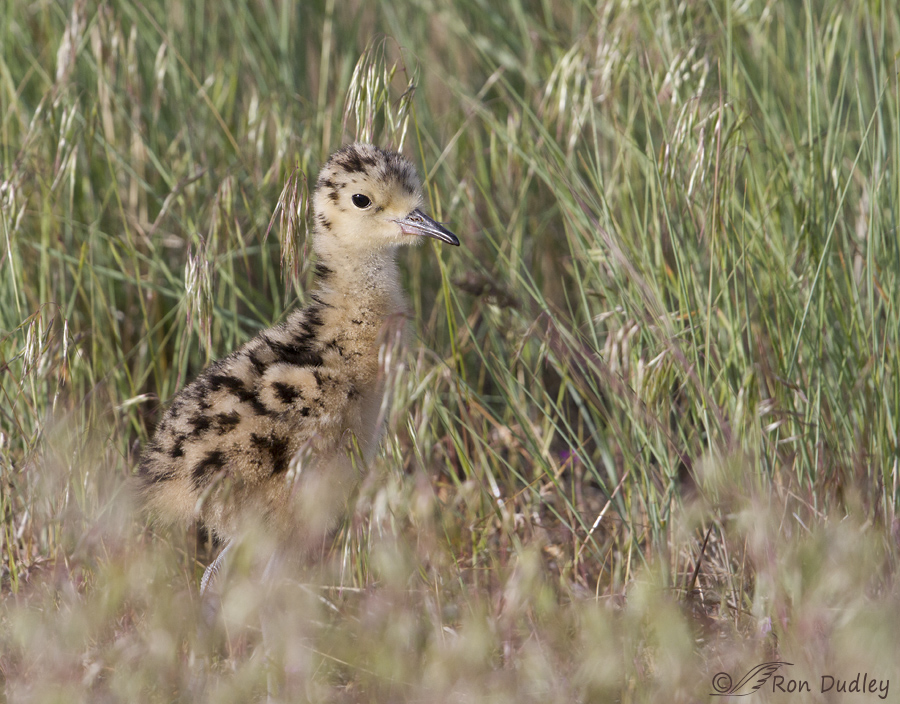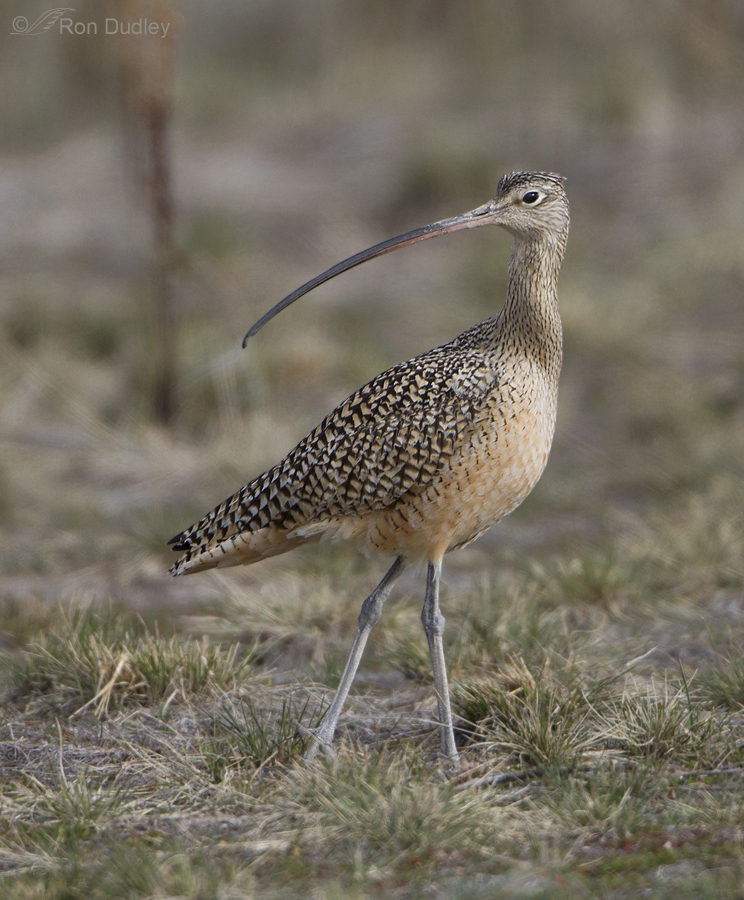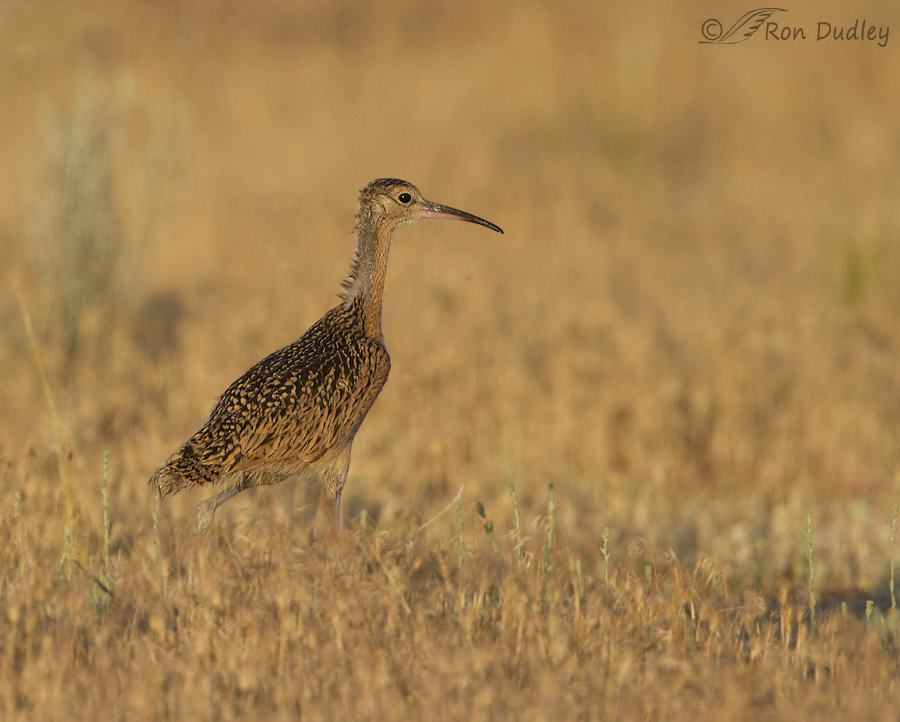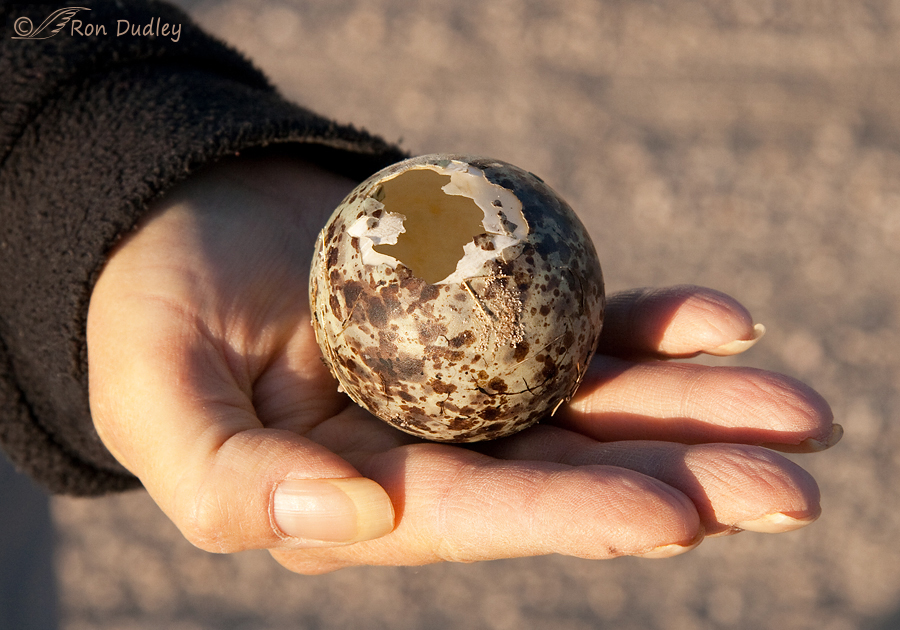Because of their somewhat limited breeding range I suspect that many have never seen a Long-billed Curlew chick so I decided to post this little cutie despite the partially obscured view of the bird.
1/1600, f/6.3, ISO 500, Canon 7D, Canon EF500mm f/4L IS II USM +1.4 tc, not baited, set up or called in
I encountered this chick and several siblings two days ago as they negotiated the thick grasses next to the main road on Antelope Island. These chicks are precocial – they hatch with eyes open and are able to walk within 5 hours and feed within 10 hours of hatching. I took a few photos from inside my pickup on the road and then moved on.
Whenever I see a curlew chick one thought inevitably goes through my mind – the amazing extent to which that little beak must quickly grow. Notice how short the bill is at this early stage (and the fact that it is already slightly decurved) and then compare it to…
1/2000, f/6.3, ISO 640, Canon 7D, Canon EF500mm f/4L IS USM +1.4 tc, not baited, set up or called in
the length of the bill of the adult which can be as long as 8.6 inches. And this growth must take place relatively quickly to allow it to feed as efficiently as the adults do. Foraging for earthworms on their breeding grounds is thought to be a primary reason for the shape and length of their bills.
1/2000, f/5.6, ISO 640, Canon 7D, Canon EF500mm f/4L IS USM +1.4 tc, not baited, set up or called in
I took this photo on the island on June 30 of last year. This youngster still has down on the back of its neck and you can see how much the bill has grown (compared to the chick in the first image) in just a few short weeks.
This is the egg from which a curlew chick must emerge. This egg was found two years ago (a rather intriguing story – more here if you’re interested). I include this image to make the obvious visually apparent – that there’s simply not enough room in the egg for the bill to grow very much before hatching.
Ron






It’s been fun hunting nests and fledglings the past couple of years and has added a fascinating dimension to birding for me. I really appreciate your post as the Long-billed Curlew doesn’t breed here. How amazing Nature is! The link to your egg story was great!
Thanks once again for the continuing (and apparently never-ending) education, Ron!
Another good opportunity for me to ID a long-billed curlew. I like the photos, thanks Ron..
Wonderful shots and interesting info Ron, thanks for sharing!
Charlotte
That’s what I enjoy about your blog – great photos associated with interesting and informative commentary.
Thanks very much, Dave. Knowing the excellent photos you take I’m delighted that I post some images of interest to you.
I hope you will forgive a personal story here, Ron.
Back in 2005, I was fly fishing for steelhead near the mouth of the Situk River, outside of Yakutat, Alaska. That’s in the skinny bit, where Southeast Alaska connects to the main part of the state. And I saw a Long-billed Curlew. It’s a big deal; at the time, there had been no documented sightings of Long-billed Curlew in Alaska. But I did not have a camera with me. I watched the bird for more than half an hour before it flew off.
I reported the siting to the bird list committee for Alaska, but, because it was not documented, it could not be “official.” In fact, it was the third undocumented sighting in the state, and the furthest west.
This year, finally, a couple found and photographed a Long-billed Curlew northwest of Juneau, Alaska, and photographed it. So I suspect that next year it will be added to Alaska’s state bird list.
The moral of the story is to always carry a camera, even when fishing.
I like personal stories, Jim. Especially yours!
That must have been a tough one to miss for you (not having your camera). That got me to thinking how often I would be without a camera and the answer is virtually never. I’ve always got at least two of them with me in my pickup (although for the sake of security the most expensive rig I own is only with me when I’m on photo trips). So I’ll likely have a camera – my problem is finding the rarity!
Judging from the shape of the hole in that egg, a Pomeranian, Papillion,, or long-haired Chihuahua emerged from it…once again, I’ve learned something interesting and new from one of your blogs….I never knew dogs came from eggs…until now, thought only birds and Easter bunnies came from eggs…
PS:Curlews and Hummingbirds, like Pinocchio, start out with short bills…unfortunately, they all lie a lot when young….the results, as they grow older, are obvious….
You make me smile, Patty!
You gave me a gift of wonder this morning! Thank you!
Hummingbirds face a similar there-is-no-room-for-that-beak-in-this-egg developmental issue. In fact, rehabilitators have worked out a formula to age orphan babies by careful measurement of the beak. It accurately predicts the fledging date.
That’s fascinating about the formula you folks have worked out for aging young hummingbirds, Mikal. I’d never heard of it but it certainly makes sense.
Every day you make me feel like I’am back to school. It’s not only the great photos but also the words that come along.
You made me smile with that remark about the shape of the hole in the egg and the Rorschach inkblots test.
It’s a pleasure to learn this way.
Thanks for sharing.
“It’s a pleasure to learn this way.”
And it’s been a pleasure to have you around the last few weeks, Jorge. I enjoy your perspective and your thoughtful comments.
How amazing. So much growth in such a short period. Here our magpie chicks beg for food (incessantly) long after they are at least the size of their parents. I have been told that even though they are fully grown that their beaks are not hard enough to be used on our summer baked ground in the search for insects.
I assume that the curlew’s beak must not only grow at the speed of light but reach maximum strength quickly too.
Elephant’s Child, I suspect you’re right – that the hardness of the bill of many species at an early age is a limiting factor on how it can be used.
Just marvelous, the whole series. I love how different the chick looks from its parents when first hatched! Thanks for opening my window on the world.
Thank you, Alison.